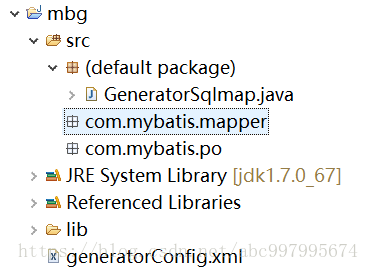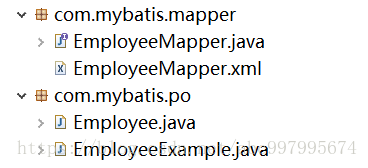什么是逆向工程
MyBatis的一个主要的特点就是需要程序员自己编写sql,那么如果表太多的话,难免会很麻烦,所以mybatis官方提供了一个逆向工程,可以针对单表自动生成mybatis执行所需要的代码(包括mapper.xml、mapper.java、po..)。一般在开发中,常用的逆向工程方式是通过数据库的表生成代码。
使用逆向工程
使用MyBatis的逆向工程,需要导入逆向工程的jar包,我用的是mybatis-generator-core-1.3.2.jar,还需要导入数据库驱动包。下面开始总结一下MyBatis逆向工程的使用步骤。
新建一个工程
我们要新建一个java工程,这个工程专门用来使用逆向工程生成代码的。
工程目录如下:

1. 配置逆向工程的配置文件
generatorConfig.xml:
<?xml version="1.0" encoding="UTF-8"?>
<!DOCTYPE generatorConfiguration
PUBLIC "-//mybatis.org//DTD MyBatis Generator Configuration 1.0//EN"
"http://mybatis.org/dtd/mybatis-generator-config_1_0.dtd">
<generatorConfiguration>
<context id="test" targetRuntime="MyBatis3">
<plugin type="org.mybatis.generator.plugins.EqualsHashCodePlugin"></plugin>
<plugin type="org.mybatis.generator.plugins.SerializablePlugin"></plugin>
<plugin type="org.mybatis.generator.plugins.ToStringPlugin"></plugin>
<commentGenerator>
<!-- 这个元素用来去除指定生成的注释中是否包含生成的日期 false:表示保护 -->
<!-- 如果生成日期,会造成即使修改一个字段,整个实体类所有属性都会发生变化,不利于版本控制,所以设置为true -->
<property name="suppressDate" value="true" />
<!-- 是否去除自动生成的注释 true:是 : false:否 -->
<property name="suppressAllComments" value="true" />
</commentGenerator>
<!--数据库链接URL,用户名、密码 -->
<jdbcConnection driverClass="com.mysql.jdbc.Driver"
connectionURL="jdbc:mysql://localhost:3306/mybatis" userId="root"
password="root">
</jdbcConnection>
<javaTypeResolver>
<!-- 默认false,把JDBC DECIMAL 和 NUMERIC 类型解析为 Integer,为 true时把JDBC DECIMAL
和 NUMERIC 类型解析为java.math.BigDecimal -->
<property name="forceBigDecimals" value="false" />
</javaTypeResolver>
<!-- 生成模型的包名和位置targetProject=".\src"表示是src文件夹下面的包 -->
<javaModelGenerator targetPackage="com.mybatis.po"
targetProject=".\src">
<!-- enableSubPackages:是否让schema作为包的后缀 -->
<property name="enableSubPackages" value="true" />
<!-- 从数据库返回的值被清理前后的空格 -->
<property name="trimStrings" value="true" />
</javaModelGenerator>
<!-- targetProject:mapper映射文件生成的位置 -->
<sqlMapGenerator targetPackage="com.mybatis.mapper"
targetProject=".\src">
<!-- enableSubPackages:是否让schema作为包的后缀 -->
<property name="enableSubPackages" value="false" />
</sqlMapGenerator>
<!-- targetPackage:mapper接口生成的位置 -->
<javaClientGenerator type="XMLMAPPER"
targetPackage="com.mybatis.mapper" targetProject=".\src">
<!-- enableSubPackages:是否让schema作为包的后缀 -->
<property name="enableSubPackages" value="false" />
</javaClientGenerator>
<!-- 要生成哪些表 -->
<table schema="" tableName="tbl_employee" domainObjectName="Employee"></table>
<!-- 有些表的字段需要指定java类型 <table schema="" tableName=""> <columnOverride column=""
javaType="" /> </table> -->
</context>
</generatorConfiguration>从上面的配置文件中可以看出,配置文件主要做的几件事是:
- 连接数据库,这是必须的,要不然怎么根据数据库的表生成代码呢?
- 指定要生成代码的位置,要生成的代码包括po类,mapper.xml和mapper.java
- 指定数据库中想要生成哪些表
执行逆向工程生成代码
配置文件都搞定了,然后就执行以下程序即可生成代码了,生成的java程序,下载的逆向工程文档中都有示例,如下:
public class GeneratorSqlmap {
public void generator() throws Exception{
List<String> warnings = new ArrayList<String>();
boolean overwrite = true;
//指定 逆向工程配置文件
File configFile = new File("generatorConfig.xml");
ConfigurationParser cp = new ConfigurationParser(warnings);
Configuration config = cp.parseConfiguration(configFile);
DefaultShellCallback callback = new DefaultShellCallback(overwrite);
MyBatisGenerator myBatisGenerator = new MyBatisGenerator(config,
callback, warnings);
myBatisGenerator.generate(null);
}
public static void main(String[] args) throws Exception {
try {
GeneratorSqlmap generatorSqlmap = new GeneratorSqlmap();
generatorSqlmap.generator();
} catch (Exception e) {
e.printStackTrace();
}
}
}执行完后刷新就可以看到生成的代码文件了:

jar包和相关参考文件可以取官网找:
https://github.com/mybatis/generator
完整代码:
https://download.youkuaiyun.com/download/abc997995674/10518823








 本文介绍MyBatis逆向工程的使用方法,包括配置文件的编写、代码生成流程及所需依赖等,帮助快速生成数据库操作代码。
本文介绍MyBatis逆向工程的使用方法,包括配置文件的编写、代码生成流程及所需依赖等,帮助快速生成数据库操作代码。
















 1686
1686

 被折叠的 条评论
为什么被折叠?
被折叠的 条评论
为什么被折叠?








